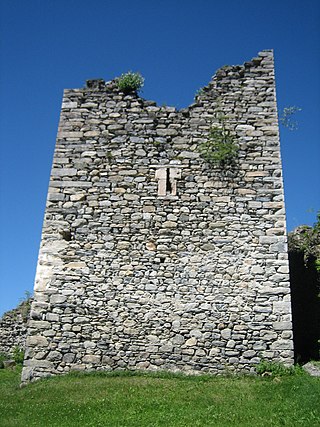
Prato is a city and comune (municipality) in Tuscany, Italy, and is the capital of the province of Prato. The city lies in the northeast of Tuscany, at an elevation of 65 metres (213 ft), at the foot of Monte Retaia. With 198,034 inhabitants as of 1 January 2024, Prato is Tuscany's second largest city and the third largest in Central Italy.

The Sforza Castle is a medieval fortification located in Milan, northern Italy. It was built in the 15th century by Francesco Sforza, Duke of Milan, on the remnants of a 14th-century fortification. Later renovated and enlarged, in the 16th and 17th centuries it was one of the largest citadels in Europe. Extensively rebuilt by Luca Beltrami in 1891–1905, it now houses several of the city's museums and art collections.

Castel del Monte is a 13th-century citadel and castle situated on a hill in Andria in the Apulia region of southeast Italy. It was built during the 1240s by King Frederick II, who had inherited the lands from his mother Constance of Sicily. In the 18th century, the castle's interior marbles and remaining furnishings were removed. It has neither a moat nor a drawbridge and some considered it never to have been intended as a defensive fortress. However, archaeological work has suggested that it originally had a curtain wall.

Finale Ligure is a comune on the Gulf of Genoa, in the province of Savona, in Liguria, Italy. It is considered part of the Italian Riviera. Part of its historical center ("Finalborgo") is one of I Borghi più belli d'Italia.

Predjama Castle is a Renaissance castle built within a cave mouth in south-central Slovenia, in the historical region of Inner Carniola. It is located in the village of Predjama, approximately 11 kilometres from the town of Postojna and 9 kilometres from Postojna Cave.

The Diocese of Prato is a Latin diocese of the Catholic Church in Tuscany, Italy, that has existed as an independent entity since 1954. Its see is Prato Cathedral, some 10 miles (17 km) northwest of Florence, on the Bisenzio River. The diocese is a suffragan of the Archdiocese of Florence.

Castel Lagopesole, or simply Lagopesole, is a village and civil parish (frazione) of the municipality (comune) of Avigliano, in Basilicata, southern Italy. It has a population of 652.

Mategriffon or Matagrifone or Mathegriffon or Rocca Guelfonia was a medieval castle in Messina, Sicily, located in what is today Viale Principe Umberto. Its strategic position upon a rocky hill close to the historic city centre gave a commanding view of the harbour and Strait of Messina. In the 19th century it was converted into a prison. Prior to its destruction in the 1908 earthquake it comprised a square dungeon with ramparts and reinforced by polygonal towers. Only an octagonal tower remains standing and is incorporated into the 20th century Shrine of Christ the King church, a visible Messina landmark which dominates its skyline.

Visconti Castle Italian: Castello Visconteo is a castle in Locarno, Switzerland. It is a Swiss heritage site of national significance.

Castelmur Castle is a castle in the village of Bondo in the municipality of Bregaglia of the Canton of Graubünden in Switzerland. It is a Swiss heritage site of national significance. The fortifications at Castelmur may be, after the Three Castles of Bellinzona, the most important example of medieval valley fortifications in modern Switzerland.

Castels Castle is a castle in the municipality of Luzein of the Canton of Graubünden in Switzerland. It is a Swiss heritage site of national significance.

Castel Manfrino is a ruined Middle Ages castle located in Sella di Castel Manfrino, near the hamlet of Macchia da Sole, within the municipality of Valle Castellana in the province of Teramo, inside the Gran Sasso e Monti della Laga National Park.
The following is a timeline of the history of the city of Prato in the Tuscany region of Italy.

Altamura Castle was a castle located in the city of Altamura, now completely demolished. It was located over today's piazza Matteotti and a few remains of it are still visible inside the adjacent buildings, which were built partly with stones and structural elements from the castle. In a warehouse are an ogival arch and some stone coats of arms. A few other remains are found in the adjacent buildings, which were built in the 19th century.

Solavers Castle is a castle in the municipality of Seewis im Prättigau of the Canton of Graubünden in Switzerland.

The Castle of the Pico is a castle in the city center of Mirandola, in the province of Modena, Italy.

The Castello Normanno-Svevo is a Normans' castle located in the historic center of Gioia del Colle. Since December 2014, the Ministry of Cultural Heritage and Activities has managed the entire castle through the Polo Museale della Puglia, which, in December 2019, became the Direzione Regionale Musei.

The castle of Barletta is the architectural result of various stratifications due to the succession of different ruling dynasties from the 11th century to the 18th century. Once a fortress for defensive purposes, surrounded by the sea that occupied the moat all around the castle and insulated it from potential enemy attacks, it constitutes a strategic point in city life as well as an important urban core. It is home to the Municipal Library, the Civic Museum and a conference and exhibition hall.


























